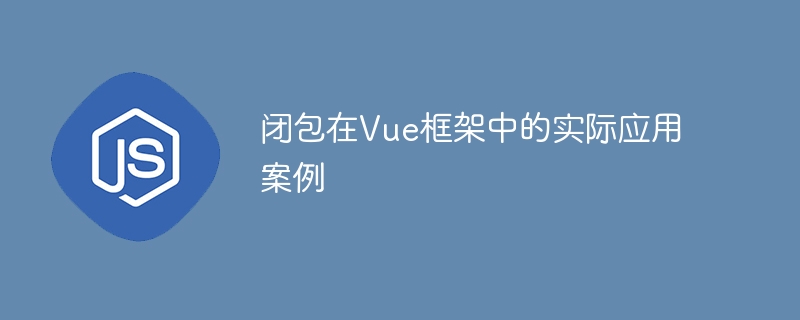

Practical application cases of closures in the Vue framework
In the Vue framework, closures are a powerful concept that can be used to create private variables and methods, and implement functions such as encapsulation and inheritance. In this article, we will introduce some concrete examples to show the practical application of closures in the Vue framework.
In the Vue framework, we usually need to create private variables and methods to encapsulate and protect data. Closures provide a concise and efficient way to achieve this.
Vue.component('private-component', (function() {
let privateVariable = '私有变量';
function privateMethod() {
console.log('私有方法');
}
return {
template: `
<div>
<p>{{ privateVariable }}</p>
<button @click="privateMethod">调用私有方法</button>
</div>
`,
data() {
return {
privateVariable: privateVariable
};
},
methods: {
privateMethod: privateMethod
}
};
})());In this example, we use an immediately invoked function expression (IIFE) to create a closure in which the private variable privateVariable and the private method privateMethod are defined. We then create a Vue component by returning an object containing the Vue component options. In Vue components, we can access and call private variables and methods.
Closures can also be used to implement the functions of encapsulation and inheritance. Below is a simple example that shows how to implement a simple encapsulation and inheritance pattern through closures.
function createAnimal(name) {
let privateVariable = '私有变量';
function privateMethod() {
console.log('私有方法');
}
return {
name: name,
speak() {
console.log(`我是${this.name}`);
},
getInfo() {
console.log(privateVariable);
},
callPrivateMethod() {
privateMethod();
}
};
}
let animal = createAnimal('小猫');
animal.speak(); // 输出:我是小猫
animal.getInfo(); // 输出:私有变量
animal.callPrivateMethod(); // 输出:私有方法In this example, we use an ordinary function to create a closure, which defines the private variable privateVariable and the private method privateMethod. We then return an object containing the public methods speak, getInfo, and callPrivateMethod, which can access and call private variables and methods. By creating a closure, we can create an Animal object and use encapsulation to access and call its methods.
Summary:
Closure is a very useful concept and has a wide range of applications in the Vue framework. By using closures, we can create private variables and methods to implement encapsulation and inheritance. In this article, we introduce some practical application cases of closures in the Vue framework and provide specific code examples. I hope these examples can help readers better understand the application of closures in the Vue framework.
The above is the detailed content of Case analysis of using closures for instances in the Vue framework. For more information, please follow other related articles on the PHP Chinese website!
 How to check server status
How to check server status
 How to solve the computer prompt of insufficient memory
How to solve the computer prompt of insufficient memory
 How to optimize a single page
How to optimize a single page
 What should I do if the web video cannot be opened?
What should I do if the web video cannot be opened?
 How to implement linked list in go
How to implement linked list in go
 How to buy and sell Bitcoin legally
How to buy and sell Bitcoin legally
 Introduction to the main work content of the backend
Introduction to the main work content of the backend
 Use of jQuery hover() method
Use of jQuery hover() method
 Why does the computer have a blue screen?
Why does the computer have a blue screen?




